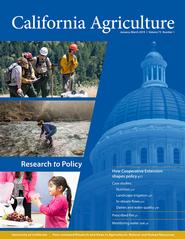All Issues

Top, UCCE Advisor Lenya Quinn-Davidson consults with a fire crew in preparation for a controlled burn near Bridgeville, Humboldt County; middle, UCCE Advisor Tracy Schohr collects a water sample below the town of Paradise, which was destroyed in the Camp Fire; bottom, an Expanded Food and Nutrition Education nutrition class in Fresno County. Photos: Evett Kilmartin, Ryan Schohr, Elëna Zhukova.
University of California Cooperative Extension specialists Van Butsic and Ted Grantham discuss cannabis research featured in a special issue of California Agriculture journal.
Volume 73, Number 1





